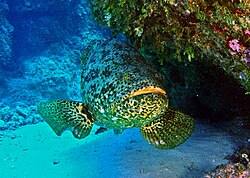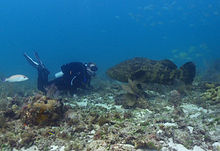Atlantic goliath grouper
| Atlantic goliath grouper | |
|---|---|
 | |
| Conservation status | |
| Scientific classification | |
| Kingdom: | Animalia |
| Phylum: | Chordata |
| Class: | Actinopterygii |
| Order: | Perciformes |
| Family: | Serranidae |
| Genus: | Epinephelus |
| Species: | E. itajara |
| Binomial name | |
| Epinephelus itajara (Lichtenstein, 1822) | |
Description
Young goliath grouper may live in brackish estuaries, canals, and mangrove swamps, unusual behavior among grouper.They may reach extremely large sizes, growing to lengths of 8.2 feet (2.5 m) and can weigh as much as 800 pounds (363 kg). The world record for a hook and line-captured specimen is 680 pounds (309 kg), caught off Fernandina Beach, Florida, in 1961.[2] They are usually around 400 pounds when mature. Considered of fine food quality, goliath grouper were a highly sought after quarry for fishermen of all types. The goliath grouper's inquisitive and generally fearless nature makes it a relatively easy prey for spear fishermen. They also tend to spawn in large aggregations, returning like clockwork to the same locations, making them particularly vulnerable to mass harvesting. Until a harvest ban was placed on the species, its population was in rapid decline. The goliath grouper is entirely protected from harvest and is recognized as a critically endangered species by the World Conservation Union (IUCN).[1] The U.S. began protection in 1990, and the Caribbean in 1993. The species' population has been recovering since the ban; with the fish's slow growth rate, however, it will take some time for populations to return to their previous levels. However, many conservationists are concerned that size-selective harvesting (seeking large fish and throwing back the small ones) may have inadvertently selected for smaller size, and fish of the size encountered so often in the mid-20th century may be lost forever.
Goliath grouper eat crustaceans, other fish, octopuses and young sea turtles. Grouper are preyed upon by large fish such as barracudas, moray eels and large sharks.
Reproduction
Goliath grouper are believed to be protogynous hermaphrodites, with individuals first maturing as females and only some large adults becoming males. Most grouper follow this pattern, but it has not yet been verified for the goliath.[3] In fact, Bullock et al. found males could be sexually mature at smaller sizes (~1150 mm) and younger ages (4–6 years) than females (~1225 mm and ~6–8 years).[4]Terminology
The goliath grouper is commonly known as the jewfish; however, in 2001 the Committee on Names of Fishes, a seven-member joint committee of the American Society of Ichthyologists and Herpetologists and the American Fisheries Society made the decision to changeSource: http://en.wikipedia.org/
More Stories: http://blackboxfishtalk.blogspot.com/


No comments:
Post a Comment